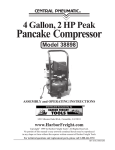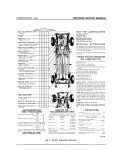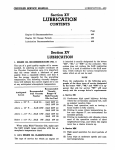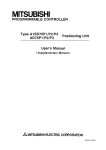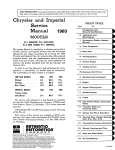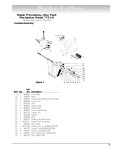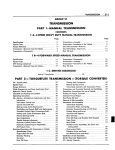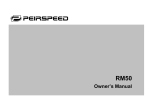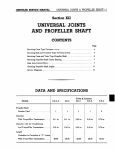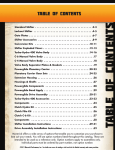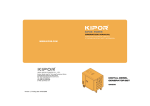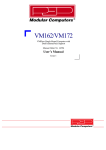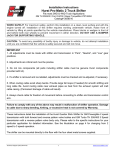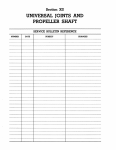Download Section XV - Lubrication
Transcript
LUBRICATION—1 CHRYSLER SERVICE MANUAL Section XV LUBRICATION CONTENTS LUBRICATION RECOMMENDATIONS 1. ENGINE OIL RECOMMENDATIONS (FIG. 1) The use of a good quality engine oil is recommended. In selecting an engine crankcase oil for Chrysler Corporation cars, it is important that the owner obtain a lubricant of good quality from a reputable refiner, and that it has the proper viscosity for the prevailing temperature. The following viscosity designations will indicate the correct engine oil to use at any anticipated atmospheric temperature. Anticipated Lowest Recommended Viscosity Recommended Range—if SAE Viscosity Multi-Viscosity Number Oils Are Used Above + 32° F SAE 3 0 . . ..SAE20W40 SAE 10W 30 Above + 10° F SAE 20W SAE 20W 40 SAE 10W 30 Above ( - 1 0 ° F.) SAE 10W SAE 10W 30 SAE 5W20 Below ( - 1 0 ° F.) SAE 5W. .SAE 5W 20 When using Multi-Viscosity Oils, make sure the SAE weight range coincides with the atmospheric temperature chart. 2. A.P.I. ENGINE OIL CLASSIFICATIONS The type of service for which an engine oil is intended is usually designated by the letters MS, MM, or ML on the container. These are service classifications established by the API (American Petroleum Institute.) This system does not replace the SAE (Society of Automotive Engineers) grade number of the oil which indicates the Viscosity or consistency of the oil recommended. For best performance and engine protection, the factory recommends that the car owner select: a. An oil which conforms to the requirements of API classification "For Service MS". b. An oil of proper SAE number in accordance with the recommendations for the anticipated temperature as shown in Paragraph 1. The factory does not recommend the use of any lubricant which does not have both an SAE designation and an MS service classification on the container. 3. MULTI-VISCOSITY OILS When using multi-viscosity oils, be sure that the SAE weight range coincides with the atmospheric temperature chart shown in Paragraph 1. 4. ENGINE OIL CHANGE PERIODS During the first 1,000 miles, leave the factory installed oil in the engine. If it is necessary to add oil during this driving period, use the proper viscosity oil according to the atmospheric temperature chart. Refer to paragraph 1, Fibrure 1. Drain the crankcase after the first 1,000 miles and refill with the proper viscosity oil for the lowest anticipated atmospheric temperature. Periodic oil changes, thereafter, using the proper grade of oil for the anticipated temperature range and designated "For Service MS" should be made every three months or 5,000 miles, whichever occurs first, more often if winter driving consists of short trips, or extreme dust or contaminated atmospheric conditions are encountered. Four quarts are necessary for refill on LC-1 and 2 and 5 quarts are necessary on LC-3 and LY-1 for refill. Add an additional quart when the oil filter element is changed. The oil level indicator is located on the left side of the engine. 5. UNUSUAL CONDITIONS Under certain conditions, more than usual care is advisable in order to keep the engine operating smoothly. In cold weather, for example, 2—LUBRICATION CHRYSLER SERVICE MANUAL 10,000 MILES 5,000 M I L E S — | I i—15,000 MILES 1,000 MILES—^ 4 ^ 4 ,^—20,000 MILES UPPER AND LOWER BALL JOINTS 4 fittings-CL KEY TO LUBRICANTS CL-Chassis Lubricant EO-Engine Oil MP-Gear Lubricant Multi-Purpose UJG—Universal Joint Grease HGL-Hypoid Gear Lubricant WBG-Wheel Bearing Grease OIL FILTER Replace GENERATOR 2 oil cups—5 drops EO POWER STEERING RESERVOIR (When so equipped) Add lubricant as necessary Automatic Transmission Lubricant Type A SPECIAL ATTENTION Recommended lubricants are based on average driving conditions. A car driven in extreme dusty, cold, or high humidity climate will require more frequent lubrication and maintenance. INTAKE PIPE AIR CLEANER Wash with kerosene—re-oil SAE 50 ENGINE CRANKCASE Drain and refill—EO as per seasonal recommendations Replace oil filter cartridge after 5-thousand miles of operation. STEERING GEARManual—add lubricant as necessary SAE 90 Fluid Gear Lubricant THESE POINTS REQUIRE NO LUBRICATION CARBURETOR AIR CLEANER Change filter element • • • • • DISTRIBUTOR Oil cup—5 drops EO Wick-2 drops EO OUTLET PIPE AIR CLEANER (Export only) Wash in Kerosene. Reoil with SAE 50 • • • • • • • • TORQUE-FLITE TRANSMISSION Check level Drain and refill Automatic Transmission Fluid Type A Rear Wheel Bearings Starting motor. Rear spring bolt and shackles. Foot accelerator and brake pedal. Propeller shaft center bearing (on long wheelbase models). Carburetor linkage and automatic choke. Rubber parts (pads, bushings, seals). Water pump and fan belt idler puller. Upper and lower control arm pivots. Steering idler arm pivot. Steering center link pivots. Carburetor air cleaner. Sway eliminator bar pivots. UNIVERSAL JOINTS Ball and trunnion type—Disassemble, clean and repack— 2 oz. UJG ADDITIONAL. LUBRICATION REAR AXLE DIFFERENTIAL Add lubricant as necessary Drain and refill— MP 1,000 Miles-CL; Parking brake linkage, Lubriplate; Door hinges and springs, hood clamps, etc., MoPar Dripless Penetrating Oil; Door striker plates, dovetails and rotor wheels, Stainless Stick Lubricant. 10,000 Miles—Speedometer wick, MoPar Speedometer Oil; Speedometer cable shaft, MoPar All-Weather Speedometer Cable Lubricant; Door lock cylinders, MoPar Lubriplate. Also check fluid level in power cylinder reservoir of coavertible top mechanism. If necessary, add MoPar Super Brake Fluid. Do not overfill. 15,000 Miles-Change air cleaner filter. 20,000 Miles-Propeller shaft splines (Imperial), clean and fill half full with Multi-purpose Rear Axle Lubricant. FRONT WHEEL BEARINGS Clean and repack—WBG TIE ROD BALL JOINTS 4 fittings—CL ENGINE OIL PAN DRAIN PLUG CONVERTOR OIL DRAIN PLUG TORQUE-FLITE TRANSMISSION drain plug RECOMMENDED TIRE PRESSURES ENGINE OIL RECOMMENDATIONS MODEl Starting Pressure (tires cold) POINTS LC-1 (Except Sub.) Front 24 Rear 22 LC-1 Suburban Front 24 Rear 24 LY-1, LC-2 & 3 Front and Rear 22 After Driving LC-1 (Except Sub.) Front 27 (tires warm) , Rear 25 LC-1 Suburban Front 25 Rear 27 LY-1, LC-2 & 3 Front and Rearstarting 25 A press/ire build-up of at least 3 pounds over pressure essnre is normal, otherwise tires are underinflated. After iast driving LC-1 (Except Sub.) Front 29 Rear 27 (tires hot) LC-1 Suburban Front 27 Rear 29 LY-1, LC-2 & 3 Front and Rear 27 A pressure build-up of at least 5 pounds over starting pressure is normal, otherwise tires are underinflated. The following viscosity designations will indicate the correct engine oil to use at any anticipated atmospheric temperature. Vitcwity ;4o. Multi-Grade Ontion, Above..32°F. SAE 30 SAE 20W-40 SAE 10W-30 Above.. 10°F. SAE 20W SAE 20W-40 SAE 10W-30 Above-10°F. SAE 10W SAE 10W-30 SAE 5W-2O Below-10°F. SAE5W SAE 5W-20 Retain original factory oil in crankcase duringfirst1,000 miles of operation. If necessary to add oil during initial period, use recommended viscosity oil shown above for lowest anticipated temperature. NEVER REDUCE O R "BLEED" BUILT-IN PRESSURE I N TIRES CAPACITIES Engine Oil-LC-l & 2 LC- 3 & LY-1 (add 1 qt. when replacingfilterelement) 4 qts. 5 qts. Cooling System-New Yorker and Imperial Windsor (with heater) 25 qts. 22 qts. Torque-Flite Transmission (refill) New Yorker and Imperial Windsor and Saratoga 10Vi qts. 9 qts. Rear Axle Differential Windsor (except Town & Country) 3Vi pts. New Yorker, all Town & Country and Imperial. 3V4 pts. Fuel Tank (except Windsor, Town & Country . 2 3 gals. Town & Country 22 gals. Windsor| 20 gals. 57x398A Fig. 1 — Chrysler Engineered Lubrication CHRYSLER SERVICE MANUAL the car should be driven at moderate speeds until the engine reaches normal operating temperature. Short trips, in which the engine does not reach normal operating temperature, may result in condensation forming in the oil pan. To protect the engine against this condition, the engine oil and the oil filter element should be changed more frequently than recommended in the regular service schedule. When driving over dusty roads for extended periods, the lubrication interval should be shortened and the carburetor air cleaner, crankcase ventilator air cleaner and oil filter should be serviced more frequently. 6. ENGINE OIL LEVEL INDICATOR The engine oil level should be checked each time the car is refueled. The engine oil level indicator, as shown in Figure 2, has two markings: "Full" and "Add Oil." If the oil level is between the "Full" and "Add Oil" marks, it is not necessary to add oil. If the oil level drops to the "Add Oil" mark, or slightly below it, add not more than one quart of oil. 7. CARBURETOR AIR CLEANER The carburetor air cleaner, as shown in Figure 3, is a heavy duty type air cleaner with a replaceable paper element and is used on all models. At 5,000 miles interval, remove the paper element, tap the dirt out with your hand gently and replace. DO NOT WASH OR OIL. When car is driven in dusty areas, the air cleaner may require more frequent servicing. Install a new MOPAR filter cartridge every 15,000 miles. LUBRICATION—3 -SHROUD WING NUT WASHER WING SCREW FILTER ELEMENT ENT BOLT /I v I * SILENCER BODY | T ^ BRACKET 58x182 Fig. 3 — Carburetor Air Cleaner is used on ALL Chrysler and Imperial models. The oil filter element should be changed every 5,000 miles to coincide with an engine oil change, after the initial engine oil change. During cold weather operation, or when the car is driven in dusty areas, more frequent replacement of the oil filter element may be necessary. 9. OIL FILTER PIPE CAP AIR CLEANER At every 5,000 miles interval, the air cleaner should be removed, thoroughly cleaned in kerosene, and re-oiled with SAE 50 Engine Oil. (SAE 40 may be used if SAE 50 is not available). When car is driven in dusty areas, the air cleaner may require more frequent servicing. 10. MANIFOLD HEAT CONTROL VALVE 8. OIL FILTER Use MOPAR Engine Care (Part Number 1643273) if control is frozen or is sticky. Apply one or two drops at each bushing. Let this penetrate a few minutes. Work valve back and forth until free. The full-flow oil filter with replaceable element 11. BALL JOINT LUBRICATION "FUU" MARK 52 x 587 Fig. 2 - T y p i c a l Engine Oil Level Indicator Lift the car at the outer ends of the lower control arms, leaving enough room for a grease gun to be used at the lower ball joint lubricant fitting. CAUTION: Do not lift the car at the frame front crossmember since this will not unload the ball joints. This can be done by using a two-pedestal hoist with the arms extended or by lifting with jacks placed under the lower control arms. As the car is lifted, the lower ball joint will be unloaded and the upper control arm (rebound) bumper will move away from its "stop" on the frame. Apply grease generously to flush out the old 4—LUBRICATION lubricant from both the upper and lower ball joints. Grease should flush out completely around the lower ball joint and from one side of the upper ball joint seal; the upper ball joints are preloaded and, therefore, cannot be unloaded to reduce the restriction to lubricant flow. At the time the grease is being applied, turn the front wheels from side to side a number of times to work the lubricant into the ball CHRYSLER SERVICE MANUAL joint better. NOTE: When grease is applied, there will be an up-and-down movement of the wheel and tire assembly at the steering knuckle. This is evidence that the ball joints are separating under pressure and is not an indication of worn parts. Lower the car to the floor and rock from side to side a number of times. Check for noises. LUBRICATION RECOMMENDATIONS 12. EVERY 1,000 MILES c. Rear Axle Refer to Lubrication Chart as shown in Figure 1, for lubrication points, lubrication procedures and lubricants ,also, refer to the following. Use Multi-Purpose Gear Lubricant SAE 90 for summer and winter above —10° F., or SAE 80 for extreme winter below —10° F. Remove filler and check level of lubricant. Replenish to level of filler hole. Do not overfill! a. Manual Steering Gear Check lubricant level at the above mileage and replenish when level is below filler hole. Do not use pressure gun! Use SAE 90 Multi-Purpose Gear Lubricant. In extremely cold weather, use SAE 80 Multi-Purpose Gear Lubricant, or dilute SAE 90 with small amount of SAE 10-W engine oil to ease steering. b. Power Steering The level of the oil in reservoir will vary according to the operating temperature of the pump. The normal operating temperature is approximately 175 degrees F. At 70 degrees F., the oil level will be approximately 3*4 inches below the top of the filler neck. The oil level should never be allowed to fall below the baffle on the reservoir. Whenever the pump is drained or removed for servicing, the pump must be filled up to the "full" mark indicated on the filler neck of reservoir before and after the engine is started. Use Automatic Transmission Fluid, Type "A". NOTE: Maintain fluid level in pump as recommended and replenish as necessary with specified lubricant. When reservoir cover is removed, do not permit dirt to fall into reservoir. It is not necessary to change the fluid for cold weather operation. d. TorqueFlite Transmission— Checking Fluid Level Apply parking brakes. Run engine at idle speed and operate the drive selector lever through all ranges and return to Neutral (N). Check level at transmission dipstick. Replenish to "L" mark if level is below the "L" mark when engine and transmission are cold; if, after operating the car for several miles, the level is below the "F" mark, replenish to the "F" mark. The oil level however should not be above the Full mark after the car has been driven sufficiently to bring the engine and transmission up to operating temperatures. e. Special Low Temperature Recommendation If it is anticipated that the average temperature range will be below (—10°) F., replace one quart of fluid with refined kerosene. This service need be performed once at the beginning of the low temperature season. Thereafter, necessary replenishment of TorqueFlite should be with Automatic Transmission Fluid, Type "A," until the next seasonal dilution or the 20,000 mile oil change. CAUTION To prevent dirt from entering the transmission, make sure the oil level indicator is properly seated in the filler tube. LUBRICATION—5 CHRYSLER SERVICE MANUAL f. Generator There are two oil cups. Apply 5 to 10 drops of Light Engine Oil to each oil cup. TORQUE CONVERTER DRAIN g. Distributor Use 5 to 10 drops of Light Engine Oil in oil cup. 13. EVERY 5,000 MILES Refer to Lubrication Chart, as shown in Figure 1, "Higher Mileage Services (5,000 Miles)." Also, refer to Paragraphs 3, 4, 5 and 6. 14. EVERY 10,000 MILES Refer to Lubrication Chart as shown in Figure 1, "10,000 Miles Interval," and also to the following information: Fig. 5 — TorqueFlite Transmission and Torque Converter Drain Points a. Front Wheel Bearings c. Speedometer Cable Use Short Fiber Wheel Bearing Grease—Medium. Check quality and quantity of lubricant. Use MOPAR All-Weather Speedometer Cable Lubricant. Disconnect cable at speedometer housing, as shown in Figure 4, and remove shaft. Coat shaft with the specified lubricant and install. NOTE: DO NOT ADD GREASE TO WHEEL BEARINGS. If grease is emulsified or in short quantity, it should be replaced. All grease should be removed from the bearings and hub, and the assembly cleaned and repacked. Add 1 % ounces of lubricant to inner surface of hub on model LC-1 only. Add 4 ounces of lubricant to inner surface of hub on models LC-2 and 3. b. Speedometer Oil Tube Wick UseMOPAR Speedometer Oil. Unscrew and remove oil tube with wick from speedometer housing (above speedometer cable flange). Saturate wick, as shown in Figure 4, with oil and replace. d. Distributor Use Light Engine Oil and MOPAR Cam Lubricant. Remove distributor rotor and apply 2 or 3 drops of Light Engine Oil to felt wick in top of cam. When replacing contact points, apply MOPAR Cam Lubricant to bumper block on distributor contact arm. Do not permit oil or lubricant to get on contact points! 15. EVERY 15,000 MILES Refer to Lubrication Chart, as shown in Figure 1, "15,000 Miles Interval." 16. EVERY 20,000 MILES Refer to Lubrication Chart, as shown in Figure 1, "20,000 Miles," and also to the information that follows: a. TorqueFlite Transmission 52x590A Fig. 4 — Speedometer and Cable Lubrication Points (Unit positioned to show Lubrication Points) Use Automatic Transmission Fluid, Type "A." To drain, remove the filler tube connector at the oil pan, as shown in Figure 5. Pull back on tube to drain. Retighten connector when drained. Remove access plate from bottom of housing and rotate torque converter until 6—LUBRICATION drain plug is accessible. Remove the plug and drain the fluid. Check the gasket on torque converter and install new gaskets, if necessary. Install drain plug and tighten. Install access plate on housing and tighten screws. To refill, apply parking brake. Add 5 quarts of Automatic Transmission Fluid, Type "A" through transmission oil pan filler tube. Start engine and add approximately 4 more quarts while engine is running. Allow engine to idle for 2 minutes. Operate the TorqueFlite Transmission drive selector push buttons through all speed ranges and push in the Neutral (N) push button. Add sufficient fluid to bring fluid level to Low mark on transmission dip stick. CHRYSLER SERVICE MANUAL tures below —30° F, Do not overfill. 17. PARTS REQUIRING NO LUBRICATION Refer to Lubrication Cha'rt, as shown in Figure 1, and to the following information: a. Rubber Bushings Do not lubricate these bushings. They are designed to grip the contracting metal parts firmly and operate as a flexible medium between these parts. The use of any lubricant will destroy the necessary friction and cause premature failure of these rubber parts. b. Oilite Bearings CAUTION To prevent dirt from entering transmission, make sure dip stick is properly seated in filler tube. b. Rear Axle Drain and refill to bottom of filler hole with Multi-Purpose Gear Lubricant SAE 90 for temperatures above —10° F., SAE 80 for temperatures below —10° F. and SAE 75 for tempera- The bearings are self-lubricating and are used in locations where lubrication is difficult to maintain. When Oilite Bearings are subjected to heat or pressure, oil seeps to the surface of the bearings to provide necessary lubrication. Oilite Bearings are available in standard sizes and can be burnished to a final running fit. They should not be reamed, filed or otherwise cut to size. If replacement is necessary, install a new Oilite Bearing of the same size.






